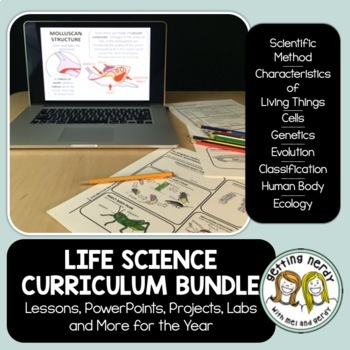Life Science Biology Curriculum Bundle - PowerPoints and Handouts
- Zip
- Google Apps™

What educators are saying
Products in this Bundle (7)
showing 1-5 of 7 products
Description
Everything you need at your fingertips! Teach an entire YEAR of life science with over 35 weeks of lessons in this curriculum bundle - including daily warm-ups, lessons, labs, activities, projects, study guides and assessments, and an animated PowerPoint for each of the following units: Scientific Method, Cells, Genetics, Evolution, Human Body, Ecology, and Classification.
WE ARE CURRENTLY IN THE PROCESS OF UPDATING WITH A DIGITAL GOOGLE CLASSROOM VERSION. KEEP AN EYE OUT FOR NOTIFICATIONS AND DOWNLOAD THE PRODUCT AGAIN TO RECEIVE THE LINKS :)
WHAT'S INCLUDED in this YEAR-LONG BUNDLE:
• 780+ slide fully editable PowerPoint presentation with title slides, objectives, bell work, guided notes, and animations along with 500+ NON-EDITABLE PDF pages which includes aligned notes, labs, projects, activities, study guide and assessments covering the following topics:
→ Scientific Method and the Nature of Science
→ Cells and Cellular Processes - DIGITAL GOOGLE CLASSROOM links completed
→ Genetics and Heredity
→ Evolution
→ Classification
→ Human Body - DIGITAL GOOGLE CLASSROOM links completed
→ Ecology and Ecosystems - DIGITAL GOOGLE CLASSROOM links completed
TO ACCESS THE MATERIALS NEEDED FOR THESE UNITS, CLICK HERE.
STUDENTS WILL:
• Follow along with the PowerPoint as they complete the aligned lessons, activities, projects and labs
CHECK OUT OUR OTHER LIFE SCIENCE PRODUCTS:
• Life Science Supplemental - Interactive Notebook, Word Wall, Task Card Bundle
• Life Science Centers / Lab Stations Bundle - Cross-curricular STEAM Activities
• Life Science & Biology Interactive Notebook Bundle
• Life Science Task Card Bundle
• Life Science Word Wall Bundle
• Dissection - Invertebrate Animals Bundle
• Dissection - Vertebrate Animals Bundle
SEE HOW THIS LESSON ALIGNS WITH THE NGSS, TEKS or GSE
Because we have created many of our own graphics or have purchased licenses to other graphics with permission, we cannot offer our resources in editable format unless otherwise stated.
TERMS OF USE (TOU):
All rights reserved by GETTING NERDY®️
• This product is to be used by the original purchaser only
• Intended for classroom and personal use only
• Copying for more than one teacher, classroom, department, school, or school system is prohibited
• This product may not be distributed or displayed digitally for public view
Failure to comply is a copyright infringement and a violation of the Digital Millennium Copyright Act (DMCA). Clipart and elements found in this PDF are copyrighted and cannot be extracted and used outside of this file without permission or license.
Life Science Curriculum Bundle - PowerPoint and Handouts © 2012 to present Getting Nerdy ®️ All Rights Reserved
www.gettingnerdyscience.com


